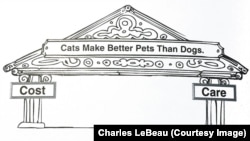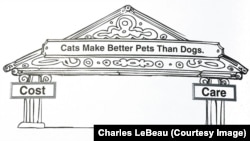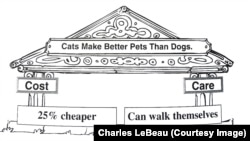As an English learner, you want to be able to understand and to discuss a subject. You want to have the ability to express your opinions, and to support that opinion with a clear argument.
You can learn these skills by learning how to debate.
What is debate?
In everyday conversation, Americans use the word debate to talk about discussions among people. When people debate, they give their own opinions about a topic.
Another use of the word debate describes a more formal discussion.
Debaters work on a team to convince a judge that their opinion about a topic has more value than the opposite side’s opinion.
The National Speech and Debate Association says that students of debate research both sides of a topic. They “learn to think critically about every argument that could be made on each side.”
Debate as a democratic skill
Debate is part of the tradition of forensics started in Ancient Greece. The Greeks thought that, in a democracy, people needed to have certain skills. These skills included speaking in public in favor of an opinion, and providing evidence to support one’s opinion.
The Greeks supported the development of these skills by holding contests. Western education today continues the tradition with competitions between debate teams.
A debate contest traditionally has this structure:
-
Teams agree to debate a resolution, a statement, such as “Nuclear power should be banned.”
-
One team is the affirmative team, in support of the resolution. One is the negative, against the resolution.
-
Each team gives an argument for or against the resolution. Then each team asks questions about the other team’s argument. After answering the questions, each team makes more statements to support their argument.
-
Finally they summarize the arguments. In a classic debate, teams may take 12 turns, in which one member of the team speaks.
If you have never seen this kind of debate, you can imagine that it is a difficult activity, even for native English speakers.
Another approach to teaching debate
Professor Charles LeBeau teaches English and debate in Japan. He says that many English teachers in Japan did not think their students could take part in a debate. The teachers had no experience with debate, and they thought it was too difficult for their students. Instead, they focused on teaching presentation.
“There is a huge gap between presentation, which is mostly a one-way experience, and then we have something on the other end of the spectrum, which is discussion. The problem with discussion is that there is no real clear, exacting format.”
Mr. LeBeau says that most “people mistake debate as being mostly a speaking skill.” But debate is a more natural kind of discussion than what happens in those classrooms. That is because debate requires understanding the other person’s opinion.
“The nice thing about debate is debate leads towards a more natural discussion…. First, I give my position and then you give your position, and then I would address each of the points in your position and comment on them. And then you would have the opportunity to address each point in my position and comment on it.”
Building a strong argument
Charles LeBeau wrote a book with Michael Lubetsky called, “Discover Debate” to help teachers understand a simpler way to teach debate. The method depends on creating a kind of visual aid known as a graphic organizer. The visual aid reflects the way we talk about critical thinking and developing an argument. Mr. LeBeau says:
“I think that an easy way to visualize the metaphor is as if it’s a house; a house has a roof, and it usually has some sort of pillars or supports, and then there is a concrete foundation.”
Students work with the idea of building their argument just like they would build a house. They would draw their house on paper or a whiteboard and list:
-
The focus of the discussion or the debate is the roof.
-
The reasons and arguments are the “pillars” to support the roof.
-
The data, numbers, examples, and expert opinions provide the concrete foundation.
The house metaphor helps students who have not experienced a debate in their own culture. It gives students a way to plan what they will say to support their message. As many nervous speakers know, having a visual aid is very helpful when speaking in public in a second language.
“In a sense they are presenting the house, they are giving the audience a tour of the house. It’s not just a bunch of words. There is something concrete and visual that is the center the debate."
In Part Two of our series next week, we will introduce the kind of debate topics that work well for English learners. Mr. LeBeau will also introduce tips for organizing a debate in a large class and judging arguments.
In Part Three, we will explain the reasons for learning to debate in business as well as the academic world. We will discuss how debating gives students a better understanding of Western culture and lets students practice critical thinking.
I'm Jill Robbins.
And I'm Jonathan Evans.
Dr. Jill Robbins wrote this story for Learning English. Hai Do was the editor.
________________________________________________________________
Words in This Story
convince – v. to cause (someone) to believe that something is true
critical thinking - n. the objective analysis and evaluation of an issue in order to form a judgment.
forensic - adj. belonging to, used in, or suitable to courts of law or to public discussion and debate
resolution - n. a formal statement that expresses the feelings, wishes, or decision of a group
affirmative - adj. saying or showing that the answer is “yes”
negative - adj. expressing denial or refusal; saying the answer is “no”
summarize - v. to tell (information) again using fewer words
classic – adj. used to describe something that has been popular for a long time
graphic - n. a picture, drawing, or graph used as a decoration or to make something (such as magazine article) easier to understand
metaphor n. an object, activity, or idea that is used as a symbol of something else
Now it’s your turn. Have you studied debate in school? What do you think about the value of debating skills? Write to us in the comments section.











